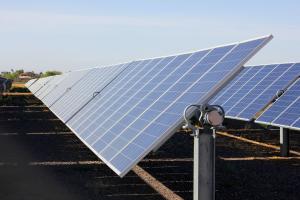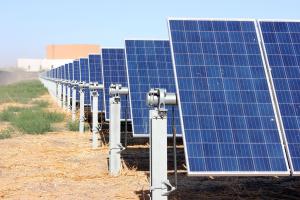Editor’s note: This is the second in a series of sustainability stories we’ll bring you over the summer. From our burrowing owl habitat and recycling efforts to our solar panels and garden, EMCC prides itself on its many sustainability practices. As Physics Professor Dr. Dwain Desbien said at the 23rd Annual Commencement Ceremony, “The best goal you can have in life is to leave the world a little better place for you having been in it.”
EMCC and sustainability are becoming synonymous. Estrella Mountain Community College is now producing its own clean energy.
Eight hundred and seventy-five solar panels, located on the west end of campus, went online Feb. 19. The first day, they produced 7,170 kilowatt-hours (kWh) of electricity. A kilowatt-hour is defined as the amount of electrical energy consumed when 1,000 watts are used for one hour.
The solar panel project began in May 2015 when the Maricopa County Community College District (MCCCD) and Solar City Corp. (now Tesla) entered into a Solar Services Agreement.
“MCCCD, wishing to obtain a portion of its electricity from sustainable resources, conducted a competitive procurement process request for proposal (RFP) to select a contractor to provide electricity using solar power,” said Randy Naughton, EMCC Facilities Director who helped coordinate the solar project.
The panels, owned and maintained by Solar City, sit on seven acres and move to follow the sun.
“Most small home systems are stationary, but as you can imagine, the ones that we have that track the sun are very efficient,” Naughton said.
The panels have already greatly reduced the college’s electric bill, but it’s not all about money.
“Solar power reduces emissions of pollutants, such as sulfur oxides, nitrogen oxides, and carbon monoxide, to the air, soil, and water,” Naughton said. “It also reduces greenhouse gases, such as carbon dioxide, methane, nitrous oxide, and hydrofluorocarbons.”
The system is expected to generate close to 4.4 million kWh its first year and more than 21.6 million kWh over the next five years.
“We’re producing clean energy,” Naughton said. “It’s the right thing to do.”

